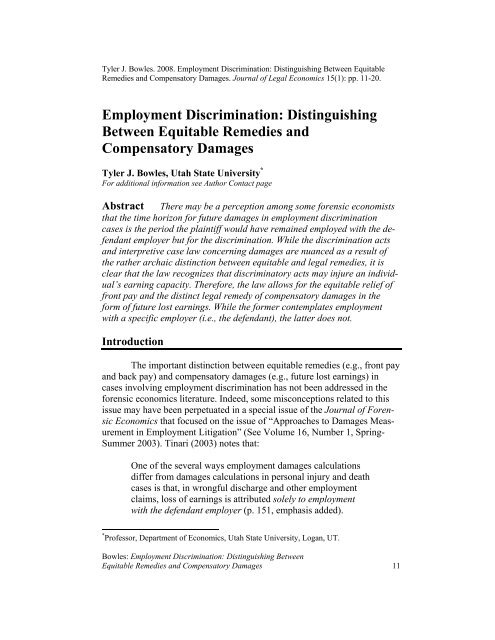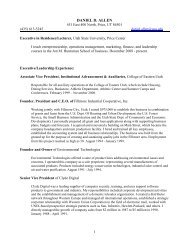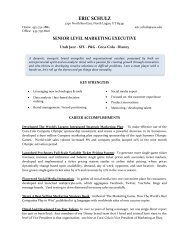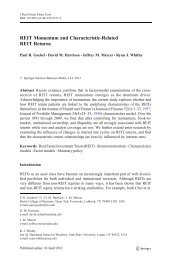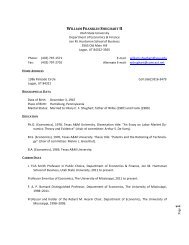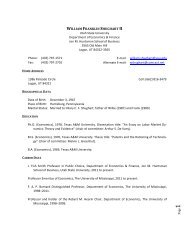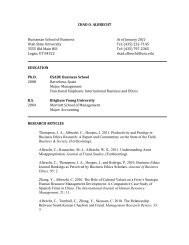Employment Discrimination - Jon M. Huntsman School of Business ...
Employment Discrimination - Jon M. Huntsman School of Business ...
Employment Discrimination - Jon M. Huntsman School of Business ...
You also want an ePaper? Increase the reach of your titles
YUMPU automatically turns print PDFs into web optimized ePapers that Google loves.
Tyler J. Bowles. 2008. <strong>Employment</strong> <strong>Discrimination</strong>: Distinguishing Between EquitableRemedies and Compensatory Damages. Journal <strong>of</strong> Legal Economics 15(1): pp. 11-20.<strong>Employment</strong> <strong>Discrimination</strong>: DistinguishingBetween Equitable Remedies andCompensatory DamagesTyler J. Bowles, Utah State University *For additional information see Author Contact pageAbstract There may be a perception among some forensic economiststhat the time horizon for future damages in employment discriminationcases is the period the plaintiff would have remained employed with the defendantemployer but for the discrimination. While the discrimination actsand interpretive case law concerning damages are nuanced as a result <strong>of</strong>the rather archaic distinction between equitable and legal remedies, it isclear that the law recognizes that discriminatory acts may injure an individual’searning capacity. Therefore, the law allows for the equitable relief <strong>of</strong>front pay and the distinct legal remedy <strong>of</strong> compensatory damages in theform <strong>of</strong> future lost earnings. While the former contemplates employmentwith a specific employer (i.e., the defendant), the latter does not.IntroductionThe important distinction between equitable remedies (e.g., front payand back pay) and compensatory damages (e.g., future lost earnings) incases involving employment discrimination has not been addressed in theforensic economics literature. Indeed, some misconceptions related to thisissue may have been perpetuated in a special issue <strong>of</strong> the Journal <strong>of</strong> ForensicEconomics that focused on the issue <strong>of</strong> “Approaches to Damages Measurementin <strong>Employment</strong> Litigation” (See Volume 16, Number 1, Spring-Summer 2003). Tinari (2003) notes that:One <strong>of</strong> the several ways employment damages calculationsdiffer from damages calculations in personal injury and deathcases is that, in wrongful discharge and other employmentclaims, loss <strong>of</strong> earnings is attributed solely to employmentwith the defendant employer (p. 151, emphasis added).* Pr<strong>of</strong>essor, Department <strong>of</strong> Economics, Utah State University, Logan, UT.Bowles: <strong>Employment</strong> <strong>Discrimination</strong>: Distinguishing BetweenEquitable Remedies and Compensatory Damages 11
While this statement may be true for employment cases that are based oncontract law, it is not correct for cases arising out <strong>of</strong> the federal discriminationstatutes (i.e., the Civil Rights Act <strong>of</strong> 1964 as amended by the CivilRights Act <strong>of</strong> 1991, hereafter the 1964 Act and the 1991 Act, respectively,or jointly as the <strong>Discrimination</strong> Acts). White, Abboud, and Holt (2003) alsoimply that future damages in discrimination cases are limited to the timeperiod during which the plaintiff would have been employed by the defendantemployer. In discussing cases involving employment discrimination,they state that “The economic losses are based upon the plaintiff’s past andfuture income specific to the employer who committed the alleged discriminatoryact” (p. 209, emphasis added).This paper discusses the fact that economic damages under the <strong>Discrimination</strong>Acts are not restricted to the equitable remedies <strong>of</strong> back pay andfront pay, which contemplate employment with the defendant employer;instead economic damages may include the compensatory damage <strong>of</strong> futurelost earnings or earning capacity as generally defined in personal injury litigation.These compensatory damages are not specific to the defendant employer.It is argued, therefore, that the law supports the economic reality thata victim <strong>of</strong> job discrimination may incur future economic damages independent<strong>of</strong> the probability <strong>of</strong> continued employment with the defendant employer.Although much <strong>of</strong> the discussion that follows is more law than economics,forensic economists working in this area should be aware <strong>of</strong> thelegal issues involved.This paper is organized as follows. In the next section, the legalframework regarding damages in employment discrimination cases is reviewed.Following that, a conceptual model <strong>of</strong> future damages in discriminationcases is presented and discussed. Finally, the conclusions are summarized.Legal BackgroundThe <strong>Discrimination</strong> Acts make a distinction between legal and equitableremedies. Historically, there was a distinction in England betweencourts <strong>of</strong> law and courts <strong>of</strong> equity. The former provided legal remedieswhile the latter provided equitable relief. Legal remedies were restricted toland, items <strong>of</strong> value, or money; equitable remedies generally involved anorder by the court requiring the defendant to perform or to refrain from performingsome specific act. Although courts <strong>of</strong> law and equity have merged(see Rule 1 <strong>of</strong> the Federal Rules <strong>of</strong> Civil Procedure), the concept <strong>of</strong> legalversus equitable remedies remains (see Jentz, Clarkson, and Miller, 1987,Journal <strong>of</strong> Legal Economics12 Volume 15, Number 1, August 2008, pp. 11-20
pp. 9-10).In the context <strong>of</strong> discrimination cases, a legal remedy would be amoney payment while an equitable remedy would be a court order to reinstatethe employee. Under the Civil Rights Act <strong>of</strong> 1964, only equitable reliefin the form <strong>of</strong> back pay and front pay in lieu <strong>of</strong> reinstatement were availableto victims <strong>of</strong> discrimination. Although back pay and front pay are, obviously,money payments, conceptually they are substitutes for technicallyimpossible or undesirable court-ordered actions for the defendant to perform.Specifically, it is illogical for the court to order the defendant to goback in time and retroactively hire the plaintiff (or pay her more) during theback-pay period and it may be undesirable for both parties for the court toorder the defendant to reinstate the plaintiff. Hence, back pay and front payare deemed to be forms <strong>of</strong> equitable relief regardless <strong>of</strong> the fact they aremoney payments.The Civil Rights Act <strong>of</strong> 1991 expanded the types <strong>of</strong> damages availableto include the legal remedy <strong>of</strong> compensatory damages, which is definedto include future pecuniary losses (Mead 2003). The 1991 Act specificallynotes that “compensatory damages . . . shall not include back pay, intereston back pay, or any other type <strong>of</strong> relief authorized under section 706(g) <strong>of</strong>the Civil Rights Act <strong>of</strong> 1964” (Civil Rights Act <strong>of</strong> 1991, 42 U.S.C. A. §1981a (b)(2)). Importantly, the 1991 Act does not indicate explicitlywhether front pay was to remain an element <strong>of</strong> equitable relief available underthe 1964 Act or was now, as a future pecuniary loss, an element <strong>of</strong> compensatorydamages, a legal remedy.This ambiguity would not have been particularly important but forthe fact that the 1991 Act imposed caps on compensatory damages. (Ascompensatory damages were capped, the plaintiff’s bar argued that front paywas not an element <strong>of</strong> compensatory damages but rather an element <strong>of</strong> equitablerelief; the defense bar argued the alternative.) Therefore, the issue <strong>of</strong>the proper classification <strong>of</strong> front pay was litigated extensively and a conflictdeveloped among the federal circuits.The United States Supreme Court took up the issue in Pollard v. E.I.du Pont de Nemours & Co. (2001). Here the Court noted that:Although courts have defined “front pay” in numerous ways,front pay is simply money awarded for lost compensationduring the period between judgment and reinstatement or inlieu <strong>of</strong> reinstatement (p. 846).The Court states further that “. . . front pay is not an element <strong>of</strong>Bowles: <strong>Employment</strong> <strong>Discrimination</strong>: Distinguishing BetweenEquitable Remedies and Compensatory Damages 13
compensatory damages within the meaning <strong>of</strong> § 1981a . . .” (p. 848).Given the concept <strong>of</strong> equitable relief and the U.S. Supreme Court’sdefinition <strong>of</strong> front pay (i.e., lost compensation during the period betweenjudgment and reinstatement or in lieu <strong>of</strong> reinstatement) and the determinationthat front pay is equitable relief, it is clear that front pay contemplatesfuture employment, but for the discrimination, with the defendant employer.Therefore, front pay damages are restricted to the future earnings the plaintiffwould have earned from the defendant employer less mitigating earnings.But what about compensatory damages as added by the Civil RightsAct <strong>of</strong> 1991?In commenting on its opinion that front pay is not an element <strong>of</strong>compensatory damages, the U.S. Supreme Court cited Williams v. Pharmacia(1998) and the Williams Court’s language that “front pay is the functionalequivalent <strong>of</strong> reinstatement . . .” (Pollard v. E.I. du Pont, p. 853). TheWilliams Court also provides insight on the central issue <strong>of</strong> this paper. Specifically,can front pay be distinguished from future lost earnings? The defendant-appellant,Pharmacia, argued that the district court erred in awardingfront pay in addition to the jury awarding lost future earnings. The SeventhCircuit affirmed the district court’s decision. The Williams Court’s languageis instructive and is here quoted at length:An award <strong>of</strong> lost future earnings is a common-law tort remedy. . . . Williams’ expert witness testified that the poorevaluations Williams received and Pharmacia’s eventual termination<strong>of</strong> her employment taint Williams’ employment record.The jury was entitled to rely on this testimony in findingthat Pharmacia’s acts <strong>of</strong> discrimination diminish Williams’future earning capacity in the same way that a physicalinjury may diminish the earning capacity <strong>of</strong> a manual laborer(p. 952).Pharmacia argues that the front pay award and the lost futureearnings award are duplicative and therefore over compensatory.As we have explained, however, the two awards compensatethe plaintiff for different injuries. Front pay in thiscase compensated Williams for the immediate effects <strong>of</strong>Pharmacia’s unlawful termination <strong>of</strong> her unemployment. Thefront pay award approximated the benefit Williams wouldhave received had she been able to return to her old job. Thedistrict court appropriately limited the duration <strong>of</strong> Williams’Journal <strong>of</strong> Legal Economics14 Volume 15, Number 1, August 2008, pp. 11-20
front pay award to one year because she would have lost herposition by that time in any event because <strong>of</strong> the merger withUpjohn.The lost future earnings award, in contrast, compensatesWilliams for a lifetime <strong>of</strong> diminished earnings resulting fromthe reputational harms she suffered as a result <strong>of</strong> Pharmacia’sdiscrimination (p. 953).This analysis by the Seventh Circuit Court is consistent with theeconomic reality that damages in the form <strong>of</strong> lost earnings may continueinto the future and involve potential jobs with other employers, as was arguedin Williams v. Pharmacia. There probably are some discriminationcases where the facts support the conclusion that the plaintiff’s earning capacityhas been diminished by the discriminatory act (see Shahnasarian,2003). In this instance, there is no reason to arbitrarily restrict the time horizonfor future damages to the period the plaintiff would have remainedemployed by the defendant. In order to develop this point further, a moreformal model is presented below.Economic AnalysisBased on the above discussion, the following is a conceptual model<strong>of</strong> future economic losses in a discrimination case:orfuture economic loss = front pay + future lost earnings(1) future economic loss =n1 n2∑∑( E − A) d + ( E −A)di i i i i ii1 i= n1+1where n 1= number <strong>of</strong> future years the plaintiff would have been expected towork for the defendant employer where the term “future” has reference tothe post-judgment period; n 2= worklife expectancy <strong>of</strong> plaintiff at time <strong>of</strong>judgment; E ifor i = 1, 2, . . ., n 1= plaintiff’s expected earnings from the defendantemployer during period i had the plaintiff been reinstated; A i=plaintiff’s alternative (i.e., mitigating) earnings during period i; E ifor i = n 1+1, n 1+ 2, . . . , n 2= plaintiff’s expected earnings during each period i but fordiscrimination; and d i= appropriate discount factor for period i.Bowles: <strong>Employment</strong> <strong>Discrimination</strong>: Distinguishing BetweenEquitable Remedies and Compensatory Damages 15
In the context <strong>of</strong> this model, it is clear that two facts are necessary tosupport a damage claim for front pay: n 1> 0 and E i> A ifor some i. The values<strong>of</strong> n 1, E iand A idepend, obviously, upon the facts <strong>of</strong> the case. It shouldbe noted that labor market theory suggests that, as a general principle, E i(i =1, 2, ..., n 1) = E i(i = n 1+ 1, n 1+ 2, ..., n 2) = A i(for all i) except for the effect<strong>of</strong> time. However, it is possible that due to the specific nature <strong>of</strong> some labormarkets, a given employer—in this case the defendant employer—may havebeen paying a higher wage to the plaintiff than what he or she could expectto have been paid by any alternative employer. (Akerl<strong>of</strong>f and Yellin (1986)provide an explanation <strong>of</strong> why some firms rationally may choose to pay awage above the market clearing price and <strong>of</strong> the empirical fact that considerablewage variability exists for a given type <strong>of</strong> job.) Another possibilitypointed out by Shahnasarian (2003) is that “. . . a less than harmonious ending<strong>of</strong> an employment relationship can stigmatize an individual among peersand employers” (p. 180). Moreover he notes that “In some cases, the psychologicalimpact <strong>of</strong> a workplace impropriety vis à vis harassment, discrimination,or wrongful termination casts longstanding, pr<strong>of</strong>ound implicationson future career development and earnings” (p. 180). In this case E i>A iand front pay is appropriate, assuming n 1> 0.Only one fact is necessary, assuming liability, to support a claim forfuture lost earnings: E i> A ifor some i. The fact that n 1= 0 does not precludea damage claim for lost future earnings although it would preclude a claimfor front pay. To illustrate this point, assume a case where the plaintiff is anemployee at will. The defendant reasonably may argue that front pay, thefunctional equivalent <strong>of</strong> reinstatement, should account for the fact that thedefendant had the right to terminate the plaintiff for any nondiscriminatoryreasons or for no reason at all. This is an odd but logically consistent argument:“Yes, we terminated her for discriminatory reasons but front payshould be zero because we will terminate her for reasons other than discriminationimmediately after being ordered to reinstate her.” While notmade in such an explicit fashion, the author has heard this argument made indiscrimination cases. This argument, however, cannot be made to reduce thecompensatory damage <strong>of</strong> lost future earnings.The different damage concepts in discrimination cases and the associatednuances <strong>of</strong>ten require more sophisticated analysis and testimony bythe forensic economist than in the typical injury case. While front pay andcompensatory damages are distinct concepts, it is easy to fall into the trap <strong>of</strong>double counting. To complicate matters, front pay is determined by a judgeafter, generally, compensatory damages have been determined by a jury(see, for example, Wade v. Transit Authority, 2006). In Williams v. Phar-Journal <strong>of</strong> Legal Economics16 Volume 15, Number 1, August 2008, pp. 11-20
macia, the court cautions district courts “. . . to be vigilant to ensure thattheir damage inquiries are appropriately combined to protect against confusionand potential overcompensation <strong>of</strong> plaintiffs” (p. 954). (Also see Nelsonv. Rehabilitation Enterprises <strong>of</strong> North Eastern Wyoming (1997)).Clearly, a forensic economist who is aware <strong>of</strong> these issues can be <strong>of</strong> greatvalue to the court in properly assessing damages and presenting testimony.As an example, consider the following hypothetical case study. Theassumed facts are as follows:1. Plaintiff, Jim, is a 55-year-old high school teacher with tenurewho was terminated by school district A in violation <strong>of</strong> theAmerican with Disabilities Act.2. <strong>School</strong> district A has never terminated a tenured teacher forcause;3. 100% <strong>of</strong> teachers in this district take early retirement at age 58.4. At the time <strong>of</strong> his termination, Jim has a work life expectancy <strong>of</strong>eight years.5. Jim’s salary and wages at the time <strong>of</strong> his termination were$72,000 and he was at the top <strong>of</strong> the salary schedule.6. His most reasonable alternative wage is working in a cabinetmanufacturing shop at an annual wage <strong>of</strong> $38,000 but with nobenefits.To focus on the main points, assume the trial takes place the day hewas terminated and ignore wage growth rates, discounting issues, and taxissues. District A could reinstate Jim and he could continue to work for thedistrict for the three years remaining before taking early retirement. In lieu<strong>of</strong> restatement, damages would be calculated according to equation (1) asfollows:(2) future economic loss = (3 years)($72,000 - $38,000) +(5 years)($38,000 - $38,000)$102,000 = $102,000 + $0In this instance, Jim’s damages include front pay but no compensatory damagesin the form <strong>of</strong> future lost earnings.Assume, alternatively, that Jim demonstrates that he would havetaken early retirement with district A at age 58 but could have taken ateaching job in another state with school district B with wages and benefitsat $65,000. Further assume he demonstrates that this unique opportunityBowles: <strong>Employment</strong> <strong>Discrimination</strong>: Distinguishing BetweenEquitable Remedies and Compensatory Damages 17
with district B has been foreclosed to him because <strong>of</strong> his termination fromdistrict A and that now his next best alternative is the cabinet shop. With thisset <strong>of</strong> facts, damages become(3) future economic loss = (3 years)($72,000 - $38,000) +(5 years)($65,000 - $38,000)$237,000 = $102,000 + $135,000Here, his losses include future lost earnings since, by assumption, the act <strong>of</strong>termination decreased his earning capacity in the period extending beyondhis projected employment with the defendant.Finally, assume the same initial facts from above but that district Ademonstrates that Jim would have taken early retirement at age 56 ratherthan 58 and that Jim takes a job with district B the day after he was terminatedby district A. Given these facts, losses are calculated as follows:(4) future economic loss = (1 year)($72,000 - $65,000) +(7 years)($65,000 - $65,000)Summary$7,000 = $7,000 + $0There may be a perception among some forensic economists that thetime horizon for future lost wages and benefits in employment discriminationcases is the period the plaintiff would have remained employed with thedefendant employer but for the discrimination. While the discrimination actsand interpretive case law concerning damages are nuanced as a result <strong>of</strong> therather archaic distinction between equitable and legal remedies, it is clearthat the law recognizes that discriminatory acts may injure an individual’searning capacity. Therefore, the law allows for the equitable relief <strong>of</strong> backpay and front pay and the distinct legal remedy <strong>of</strong> compensatory damages inthe form <strong>of</strong> future lost earnings. While the former contemplates employmentwith the defendant-employer, the latter does not.Journal <strong>of</strong> Legal Economics18 Volume 15, Number 1, August 2008, pp. 11-20
ReferencesAkerl<strong>of</strong>f, George A., and Janet L. Yellen, eds., 1986. Efficiency Wage Models<strong>of</strong> the Labor Market. Cambridge: Cambridge University Press.Jentz, Gaylord A., Kenneth W. Clarkson, and Roger LeRoy Miller, 1987.West’s <strong>Business</strong> Law: Alternative UCC Comprehensive Edition, 3 rd .New York: West Publishing Company.Mead, Marisa J., 2003. “Taxing the victims: compensatory damage awardsand attorneys’ fees in sexual harassment lawsuits,” Journal <strong>of</strong> Lawand Policy, 11: 801-860.Shahnasarian, Michael, 2003. “Front pay damage assessment: a summary <strong>of</strong>vocational and psychological considerations,” Journal <strong>of</strong> ForensicEconomics, 16(1): 177-184.Tinari, Frank D., 2003. “Approaches to damages measurement in employmentlitigation: an introduction,” Journal <strong>of</strong> Forensic Economics,16(1): 151-152.White, Paul F., Josefina V. Abboud, and Fredrick M. Holt, 2003. “The use<strong>of</strong> attrition rates for economic loss calculations in employment discriminationcases. A hypothetical study,” Journal <strong>of</strong> Forensic Economics,16(1), 209-223.Federal Code and Court RulesCivil Rights Act <strong>of</strong> 1964, 42 U.S.C. § 2000e (2006).Civil Rights Act <strong>of</strong> 1991, 42 U.S.C. § 1981(a) (2006).Federal Rules <strong>of</strong> Civil Procedure, 2006, R1.Small <strong>Business</strong> Job protection Act <strong>of</strong> 1996, Public Law No. 104-188, 110Stat. 1755 (1996).Case LawPollard v. E. I. du Pont de Nemours & Co. v. 532 U.S. 843 (2001).Bowles: <strong>Employment</strong> <strong>Discrimination</strong>: Distinguishing BetweenEquitable Remedies and Compensatory Damages 19
Williams v. Pharmacia, Inc. 137 F.3d 944 (1998).Wade v. Transit Authority 2006 U.S. Dist. Lexis 16447 (2006).Nelson v. Rehabilitation Enterprises <strong>of</strong> North Eastern Wyoming 124 F.3d217 (1997).Journal <strong>of</strong> Legal Economics20 Volume 15, Number 1, August 2008, pp. 11-20


